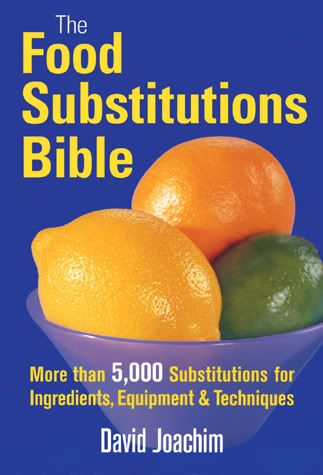The Art of Substitution
 A handful of red peppers in lieu of snow peas won’t make or break your stir-fry. The only difference is a variation in colour and which family member picks out their most hated vegetable.
A handful of red peppers in lieu of snow peas won’t make or break your stir-fry. The only difference is a variation in colour and which family member picks out their most hated vegetable.
Adventurous carnivores can swap pork for beef or lamb in a curry with impunity. Any firm meat will produce a savory stew perfect for ladling over rice. So, what’s the big deal about substitutions?
When you’re baking? Plenty. Our family still tells the story of a well-meaning, health-conscious relative who couldn’t figure out why her baking emerged from the oven looking more like clay than cake. After a bit of probing, we found out she substituted whole wheat flour for cake and pastry, commercial sour cream for soured milk, honey for sugar (or “white death” as she called it) and sunflower oil for cold butter. Any one of those changes would have ruined the coffee cake, but four ill-conceived alterations? Even the birds refused this kitchen disaster.
Now, I know enough not to swap whole wheat for white flour, but are all purpose and cake and pastry interchangeable? The answer is complex. If the recipe calls for all purpose you can substitute an equal amount of cake and pastry, except with cookies, and if substituting in reverse the ratio changes to — oh heck, just buy David Joachim’s The Food Substitution Bible.
Thorough, easy to use and chock full of storage advice, equipment techniques and healthy alternatives, this book earned its coveted IACP Cookbook Award. (Note: Although the #1 Google hit will tell you this stands for the International Association of Chiefs of Police, I assure you the award is given by Culinary Professionals, not law enforcement officers.)
Don’t give a dried fig about appropriate alternatives? How about caring an equal amount of pitted dried dates, pitted prunes, raisins or dried apricots? Joachim even tells you how to store dried figs and offers practical weight to volume ratios.
The alphabetical listing is handy for those times when someone you live with drinks the last of the pomegranate juice the recipe calls for and doesn’t tell you, or hates the main ingredient in the dish you’ve chosen to make, in this case Brussels sprouts. (It’s okay Andrew, Joachim says we can use broccoli florets, which are milder and cook faster, or chopped green cabbage, which doesn’t alter the taste much and just cooks faster. Broccoli it is!)
Detailed charts comparing types of apples, pears, dried beans, olives, chilies and rice (to name a few) are invaluable when you can’t get the variety you need or want to try something different. Joachim rounds the book off with metric conversions, volume equivalents, more than 125 classic recipes, and a section on high altitude baking. Now that’s what I call providing something for everyone.